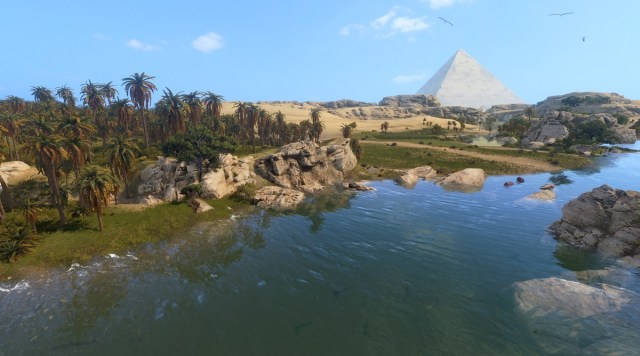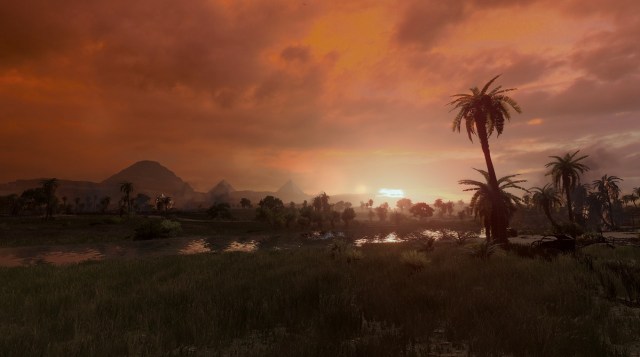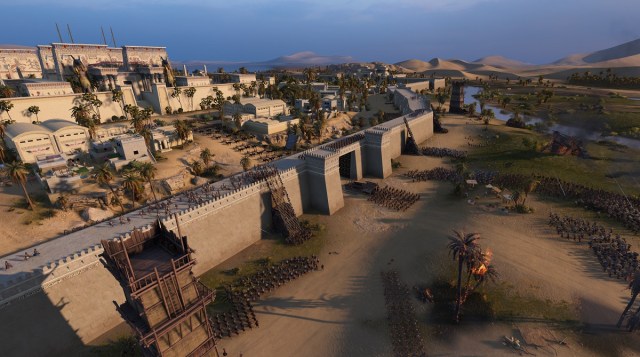Does that matter?
I’ve put hundreds of hours into Creative Assembly’s Total War series, starting way back with Rome: Total War. I haven’t played all the titles, but more than a few. Getting to try out the next game in the series, Total War: Pharaoh, was a tantalizing proposition. The new features they’re showing off sound pretty appreciable.
I was given the chance to preview three different battle setups within Total War: Pharaoh. Mainly, they highlight the new weather systems, but the third battle option had me defending against a siege on a city; the perfect playground to watch burn.
Having conquered the battlefield, I can tell you that this is the same Total War experience, at least when it comes to battles. Neat little rows of dudes with different strengths and weaknesses and a lot of micromanaging on the field. That’s not exactly a condemnation. The added features are noticeable and integrate so well with the established mechanics that it’s hard to believe they weren’t there in the same form before.
Dust in the wind
Total War: Pharaoh takes the series to the earliest period it has seen, the end of the bronze age. The thing about that period is that they still had swords, shields, and bows, so from a combat perspective, it’s not much different.
In the first battle, where I used the leader Ramesses against Seti, I used the same tactics that had always worked for me. I put bows in front of my line and advanced slowly until they were within range. Once I provoked the AI, I drew them back behind my lines and intercepted their charge. After a short time, Seti joined the fray. I prioritized taking down the general while maintaining my lines. Once the general goes down, it isn’t difficult to break the morale of the various groups and send them fleeing, which is exactly what happened.
Midway through the battle, however, a sandstorm rolled in. This reduces visibility but had little effect on the difficulty of the Total War: Pharaoh demo. There’s an active pause, so reduced visibility just meant using that more frequently to check on the overall battle progression.

It’s a fun name to say
Next was Ramesses versus Suppiluliuma. While the last battle played out between open sand dunes, this time around, there was a little more vegetation. No time to test out the fire mechanic, however, as the battle starts in the rain. It only gets worse from there, progressing to a thunderstorm.
The briefing let us know that the mud would affect troop movement. However, if this was the case, it was kind of difficult to tell. I’m not sure how intimate you are with individual troop movement, but I can tell you that I don’t pay that much attention. When you have hordes of troops, you can’t find much time to become really acquainted with a particular type of them. I did notice that the mud spatters on the troops, which is pretty cool.
The other feature of this battle that wasn’t in the previous entries was chariots. I was always kind of terrible with mounted units. They require too much attention to use effectively. Whenever I’d play co-op campaigns, one of us would take control of mounted units, while the other would take everything else, just so that more focus could be given to their movements. As such, even in Total War: Pharaoh, I think I sucked with the chariots.

Standing in fire
Finally, we come to the siege. The Siege battles have always been both the coolest and most time-consuming features in the Total War games. This one took place in the city of Mennefer, and it featured stacked armies.
The battle opens with the enemy approaching on four gates. They’ve got siege towers and battering rams on each of these, so I had to keep the defense on all of them. Unfortunately, they quickly penetrated my southern gate, and despite my efforts, managed to get some siege towers on the wall.
Unfortunately for them, all the wall crawlers got repelled, which means only the south wall was truly breached. Weirdly, he chose to separate his troops to go to capture points. This would have led to a quick victory if I had been distracted, but I merely needed to redirect some of my units (my chariots, in particular) to kick them off the capture points, and eventually, they all broke. As the battle with the highest difficulty rating, I felt a little perplexed about why I had such an easy time.
On the other hand, I finally got to see fire at play. It, once again, wasn’t terribly impactful. It was cool to see stray fire arrows ignite the houses in the city and see them burn throughout, but I kind of feel this was a feature going back to, at least, Total War: Shogun 2. Mostly, it was a problem because one of my units was left standing in some vegetation that was lit on fire, but the AI also left a unit on there as well, so…

A little more muddy
As I said, the battles in Total War: Pharaoh aren’t anything majorly different. In the briefing, we were told that battles were slowed down a bit, but I honestly couldn’t tell. It felt the same to me, and it’s not like this is after a long period of not interacting with the series.
With that in mind, however, being the same from a battle standpoint isn’t a huge problem. It at least means they didn’t make a big change and screw everything up, and after over two decades of consistency, seeing that continue isn’t a surprise at all.
I’m always more interested in the campaign anyway. Creative Assembly hasn’t shown off much of that yet, but it promises to be more dynamic than the ones in the past. I’m hopeful. The Total War series has never severely let us down, and Total War: Pharaoh is definitely on the right foot. I’m looking forward to jumping into another co-op campaign sometime later in the year.














Published: Jun 1, 2023 11:00 am